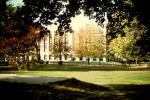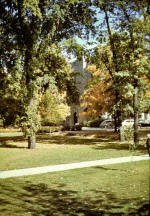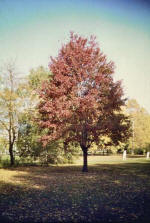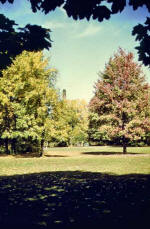Thut Presentation Page 2
 The lake as seen from the Botany Laboratory in April, 1919. On the west side of the campus along Fourth Street, this is Lake Ahmoweenah, it was not as big as the funny little plans I showed you earlier, but this is Lake Ahmoweenah. And this road just touches the west end of Old Main going straight south. And this sidewalk goes straight south down yonder to Schahrer Field. This is a cottonwood tree. See that cottonwood tree? Ready?
The lake as seen from the Botany Laboratory in April, 1919. On the west side of the campus along Fourth Street, this is Lake Ahmoweenah, it was not as big as the funny little plans I showed you earlier, but this is Lake Ahmoweenah. And this road just touches the west end of Old Main going straight south. And this sidewalk goes straight south down yonder to Schahrer Field. This is a cottonwood tree. See that cottonwood tree? Ready?  McAfee Gym was built in 1938. There's the cottonwood tree. Right there, of course it's many years older. So when McAfee gym was built... originally it was Lantz Gym... the man in Springfield said, "There's nothing on that part of the campus, we'll set McAfee Gym there." So all we had to do was drain Lake Ahmoweenah and set the gymnasium in it and we now have this cottonwood tree right there. So there has been quite a bit of change in scenery.
McAfee Gym was built in 1938. There's the cottonwood tree. Right there, of course it's many years older. So when McAfee gym was built... originally it was Lantz Gym... the man in Springfield said, "There's nothing on that part of the campus, we'll set McAfee Gym there." So all we had to do was drain Lake Ahmoweenah and set the gymnasium in it and we now have this cottonwood tree right there. So there has been quite a bit of change in scenery.  University Lakes in September, 1973. Since Lake Ahmoweenah was a lake and it was kind of low they had to have some earth so they went down across Fourth Street and had earth "gulpers", earthmovers, pick up earth, so Lake Ahmoweenah up there disappeared but the campus lake appeared. And, they not only more or less closed up the lake but also made other changes of the topography of the campus. This is the lake as you all should know.
University Lakes in September, 1973. Since Lake Ahmoweenah was a lake and it was kind of low they had to have some earth so they went down across Fourth Street and had earth "gulpers", earthmovers, pick up earth, so Lake Ahmoweenah up there disappeared but the campus lake appeared. And, they not only more or less closed up the lake but also made other changes of the topography of the campus. This is the lake as you all should know.  Science Building in 1942. Early on, just South of Old Auditorium or the Art Center, there was this cistern and the rainwater from the roof of Old Auditorium filled this cistern and it was used to supply the boilers in the little powerhouse just down the way. There is the Physical Science building [built in 1939]. It used to be the Science Building, not the Physical Science Building because Botany and Zoology were in there too for some years. But now its Physics, Chemistry and Geography. But the cistern in a year or two - this cistern disappeared.
Science Building in 1942. Early on, just South of Old Auditorium or the Art Center, there was this cistern and the rainwater from the roof of Old Auditorium filled this cistern and it was used to supply the boilers in the little powerhouse just down the way. There is the Physical Science building [built in 1939]. It used to be the Science Building, not the Physical Science Building because Botany and Zoology were in there too for some years. But now its Physics, Chemistry and Geography. But the cistern in a year or two - this cistern disappeared.  Science Building in 1949. This is approximately the same picture and there is no cistern because we're using city water now with treatment. We don't have to use a cistern of water off the roof of Old Main.
Science Building in 1949. This is approximately the same picture and there is no cistern because we're using city water now with treatment. We don't have to use a cistern of water off the roof of Old Main.  West end of Old Main in 1942. This is the west end of Old Main. The main road went right by the west end of the door there. This is an elm tree. You will discover on the next picture that this sidewalk, well- ah - the road has disappeared, but this sidewalk was moved closer over here.
West end of Old Main in 1942. This is the west end of Old Main. The main road went right by the west end of the door there. This is an elm tree. You will discover on the next picture that this sidewalk, well- ah - the road has disappeared, but this sidewalk was moved closer over here.  West end of Old Main in January, 1967. There's the sidewalk - right there. This is the elm tree. Theoretically it should have had Phloem Necrosis along with a lot of other elm trees. Now I can't prove it and this is unscientific, but I think this elm tree has survived because they filled up the space between Old Main and Pem Hall. There was a low spot here about 2 feet down, and they filled it up and they buried the roots of this tree about 2 feet. So I don't think this elm tree ever suffered from drought. And when elm trees suffer from drought they're very subject to Phloem Necrosis. Well, this tree is still with us, thank goodness, a beautiful tree right there.
West end of Old Main in January, 1967. There's the sidewalk - right there. This is the elm tree. Theoretically it should have had Phloem Necrosis along with a lot of other elm trees. Now I can't prove it and this is unscientific, but I think this elm tree has survived because they filled up the space between Old Main and Pem Hall. There was a low spot here about 2 feet down, and they filled it up and they buried the roots of this tree about 2 feet. So I don't think this elm tree ever suffered from drought. And when elm trees suffer from drought they're very subject to Phloem Necrosis. Well, this tree is still with us, thank goodness, a beautiful tree right there.  East side of McAfee Gym in 1954. Here is McAfee Gym and we had several temporary buildings east of McAfee Gym and here are some of the buildings [on the right].
East side of McAfee Gym in 1954. Here is McAfee Gym and we had several temporary buildings east of McAfee Gym and here are some of the buildings [on the right].
 Cafeteria, ca. 1943. [We are] facing east and looking through the two trees at the temporary building which housed the cafeteria. This slide was made from a picture taken about 1943. They taught Geography, especially Psychology, some language and some other things in this building. Now these three trees here, I went by this spot one day and saw Mr. Monere who was grounds keeper at that time. I said, "Mr. Monere, what do these stakes mean over here?" "Oh, we're going to put a temporary building in here." "What are you going to do with these trees?" "Well," he said, "I guess we'll just have to cut them down." I said, "You go and tell Dr. Buzzard to move the building ten feet. And you say I said so." Well, he went to see Greg the business manager and Greg said, "Well, you better see Dr. Buzzard." And, sure enough---they moved the building 10 feet! And, we saved the trees! Thank goodness! Some times you have to be obstinate to get your wish.
Cafeteria, ca. 1943. [We are] facing east and looking through the two trees at the temporary building which housed the cafeteria. This slide was made from a picture taken about 1943. They taught Geography, especially Psychology, some language and some other things in this building. Now these three trees here, I went by this spot one day and saw Mr. Monere who was grounds keeper at that time. I said, "Mr. Monere, what do these stakes mean over here?" "Oh, we're going to put a temporary building in here." "What are you going to do with these trees?" "Well," he said, "I guess we'll just have to cut them down." I said, "You go and tell Dr. Buzzard to move the building ten feet. And you say I said so." Well, he went to see Greg the business manager and Greg said, "Well, you better see Dr. Buzzard." And, sure enough---they moved the building 10 feet! And, we saved the trees! Thank goodness! Some times you have to be obstinate to get your wish.  Union, June, 1969. Looking southwest through the same two trees at the Union. Unfortunately only two of these trees are left. Instead of looking southeast we are now looking southwest. The third one died of what do you call it, cementitis? There was too much cement around it.
Union, June, 1969. Looking southwest through the same two trees at the Union. Unfortunately only two of these trees are left. Instead of looking southeast we are now looking southwest. The third one died of what do you call it, cementitis? There was too much cement around it.  Sunken Garden. A sunken garden took up the south part of the old lake site. South of McAfee Gym, even when Lake Ahmoweenah was filled up, there was this low spot and in this low spot Dr. Buzzard put his extra iris so we had an iris garden over here, just south of McAfee gym.
Sunken Garden. A sunken garden took up the south part of the old lake site. South of McAfee Gym, even when Lake Ahmoweenah was filled up, there was this low spot and in this low spot Dr. Buzzard put his extra iris so we had an iris garden over here, just south of McAfee gym.  Sunken garden, April, 1969. The sunken garden is now gone. There is the water tower and here is the chimney of the powerhouse. And looking the same direction in the same picture [above] there it is, there's the chimney. See, I don't have to change my pointer very much to show you the chimney. This happens to be an English Walnut tree that I swiped, or was given to me from down at Toledo, by Mrs. Icenogle. Mrs. Icenogle gave me that tree. There was nothing for a long time southeast from the temporary buildings except sitting down here was a grove. This grove was planted real early and a few of those trees in the grove are still here. The Life Science Building was planted in the middle of this grove. But, there are a few pines along Seventh street. There are a few sweet gums along there. There are a few ash along there. There are still remnants of a rather attractive little grove that they had down there.
Sunken garden, April, 1969. The sunken garden is now gone. There is the water tower and here is the chimney of the powerhouse. And looking the same direction in the same picture [above] there it is, there's the chimney. See, I don't have to change my pointer very much to show you the chimney. This happens to be an English Walnut tree that I swiped, or was given to me from down at Toledo, by Mrs. Icenogle. Mrs. Icenogle gave me that tree. There was nothing for a long time southeast from the temporary buildings except sitting down here was a grove. This grove was planted real early and a few of those trees in the grove are still here. The Life Science Building was planted in the middle of this grove. But, there are a few pines along Seventh street. There are a few sweet gums along there. There are a few ash along there. There are still remnants of a rather attractive little grove that they had down there.  Soft maple located where the Home Management Houses were built. The Home Economics Department decided that they had to have practice houses. The State built two practice houses so the Home Ecers could move in for a quarter and live in these houses. They even got a baby so they could take care of a baby as a family unit in these practice houses.
Soft maple located where the Home Management Houses were built. The Home Economics Department decided that they had to have practice houses. The State built two practice houses so the Home Ecers could move in for a quarter and live in these houses. They even got a baby so they could take care of a baby as a family unit in these practice houses.  Home Management Houses as viewed from the Union location. But in a few years they got tired of having practice houses. These buildings were built way down there - way down there - what in the world did they want them way down there for anyway?
Home Management Houses as viewed from the Union location. But in a few years they got tired of having practice houses. These buildings were built way down there - way down there - what in the world did they want them way down there for anyway?
 The same soft maple looking north from the old picnic grounds located in the woods. Now I'm looking north from the grove that was in the southeast corner of the campus and this is the corner of Seventh Street and Cleveland where the Life Science Building is. Just back of here would be the Life Science Building. There is the power house chimney. We are looking straight north now, and this is a soft maple.
The same soft maple looking north from the old picnic grounds located in the woods. Now I'm looking north from the grove that was in the southeast corner of the campus and this is the corner of Seventh Street and Cleveland where the Life Science Building is. Just back of here would be the Life Science Building. There is the power house chimney. We are looking straight north now, and this is a soft maple.  April, 1969 close up of one of the Home Management houses built in 1948. We are looking the same direction. These are those practice houses and the chimney is right there. I don't know what they are now. They've changed so much now that I can't keep up with them. Doesn't make too much difference, I guess.
April, 1969 close up of one of the Home Management houses built in 1948. We are looking the same direction. These are those practice houses and the chimney is right there. I don't know what they are now. They've changed so much now that I can't keep up with them. Doesn't make too much difference, I guess.  Looking north toward the powerhouse in February, 1966. In time, between the chimney and the practice houses, they built this Music - Art complex. So here we have the practice houses and the greenhouses, taken from the Life Science Building. That's the water tower. Now, I want you to watch the water tower ‘cause it grows rapidly.
Looking north toward the powerhouse in February, 1966. In time, between the chimney and the practice houses, they built this Music - Art complex. So here we have the practice houses and the greenhouses, taken from the Life Science Building. That's the water tower. Now, I want you to watch the water tower ‘cause it grows rapidly. Another view looking north from the Life Sciences Building. See? See how it grew? This little water tower was, of course, after a few years eliminated and we just have the big water tower instead of the little one. But it's the same picture and that's the sort of thing that happens.
Another view looking north from the Life Sciences Building. See? See how it grew? This little water tower was, of course, after a few years eliminated and we just have the big water tower instead of the little one. But it's the same picture and that's the sort of thing that happens.  Looking southeast from the Union at the Home Management Houses. We're looking now from the Union, more or less southeast toward the Art Building. Down toward the practice houses. Beyond you can see Buzzard Laboratory School. None of these you see were here. All of these buildings I saw erected.
Looking southeast from the Union at the Home Management Houses. We're looking now from the Union, more or less southeast toward the Art Building. Down toward the practice houses. Beyond you can see Buzzard Laboratory School. None of these you see were here. All of these buildings I saw erected.  Fine Arts Building and new wing in October, 1972. And here is the new addition to this Music Building on Seventh Street.
Fine Arts Building and new wing in October, 1972. And here is the new addition to this Music Building on Seventh Street.
Thut Presentation Page 1 Thut Presentation Page 2 Thut Presentation Page 3 Thut Presentation Page 4